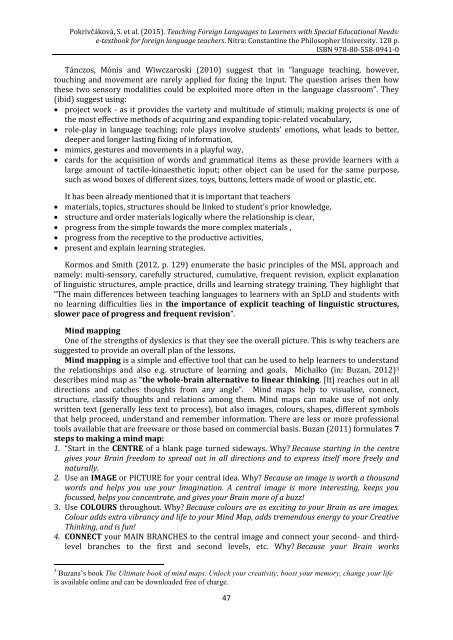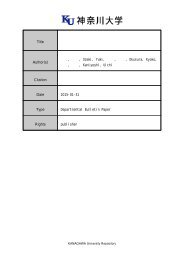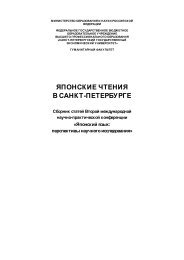to Learners with Special Educational Needs
e-textbook SEN
e-textbook SEN
You also want an ePaper? Increase the reach of your titles
YUMPU automatically turns print PDFs into web optimized ePapers that Google loves.
Pokrivčáková, S. et al. (2015). Teaching Foreign Languages <strong>to</strong> <strong>Learners</strong> <strong>with</strong> <strong>Special</strong> <strong>Educational</strong> <strong>Needs</strong>:<br />
e-textbook for foreign language teachers. Nitra: Constantine the Philosopher University. 128 p.<br />
ISBN 978-80-558-0941-0<br />
Tánczos, Mónis and Wiwczaroski (2010) suggest that in “language teaching, however,<br />
<strong>to</strong>uching and movement are rarely applied for fixing the input. The question arises then how<br />
these two sensory modalities could be exploited more often in the language classroom”. They<br />
(ibid) suggest using:<br />
project work - as it provides the variety and multitude of stimuli; making projects is one of<br />
the most effective methods of acquiring and expanding <strong>to</strong>pic-related vocabulary,<br />
role-play in language teaching; role plays involve students’ emotions, what leads <strong>to</strong> better,<br />
deeper and longer lasting fixing of information,<br />
mimics, gestures and movements in a playful way,<br />
cards for the acquisition of words and grammatical items as these provide learners <strong>with</strong> a<br />
large amount of tactile-kinaesthetic input; other object can be used for the same purpose,<br />
such as wood boxes of different sizes, <strong>to</strong>ys, but<strong>to</strong>ns, letters made of wood or plastic, etc.<br />
It has been already mentioned that it is important that teachers<br />
materials, <strong>to</strong>pics, structures should be linked <strong>to</strong> student’s prior knowledge,<br />
structure and order materials logically where the relationship is clear,<br />
progress from the simple <strong>to</strong>wards the more complex materials ,<br />
progress from the receptive <strong>to</strong> the productive activities,<br />
present and explain learning strategies.<br />
Kormos and Smith (2012, p. 129) enumerate the basic principles of the MSL approach and<br />
namely: multi-sensory, carefully structured, cumulative, frequent revision, explicit explanation<br />
of linguistic structures, ample practice, drills and learning strategy training. They highlight that<br />
“The main differences between teaching languages <strong>to</strong> learners <strong>with</strong> an SpLD and students <strong>with</strong><br />
no learning difficulties lies in the importance of explicit teaching of linguistic structures,<br />
slower pace of progress and frequent revision”.<br />
Mind mapping<br />
One of the strengths of dyslexics is that they see the overall picture. This is why teachers are<br />
suggested <strong>to</strong> provide an overall plan of the lessons.<br />
Mind mapping is a simple and effective <strong>to</strong>ol that can be used <strong>to</strong> help learners <strong>to</strong> understand<br />
the relationships and also e.g. structure of learning and goals. Michalko (in: Buzan, 2012) 3<br />
describes mind map as “the whole-brain alternative <strong>to</strong> linear thinking. [It] reaches out in all<br />
directions and catches thoughts from any angle”. Mind maps help <strong>to</strong> visualise, connect,<br />
structure, classify thoughts and relations among them. Mind maps can make use of not only<br />
written text (generally less text <strong>to</strong> process), but also images, colours, shapes, different symbols<br />
that help proceed, understand and remember information. There are less or more professional<br />
<strong>to</strong>ols available that are freeware or those based on commercial basis. Buzan (2011) formulates 7<br />
steps <strong>to</strong> making a mind map:<br />
1. “Start in the CENTRE of a blank page turned sideways. Why? Because starting in the centre<br />
gives your Brain freedom <strong>to</strong> spread out in all directions and <strong>to</strong> express itself more freely and<br />
naturally.<br />
2. Use an IMAGE or PICTURE for your central idea. Why? Because an image is worth a thousand<br />
words and helps you use your Imagination. A central image is more interesting, keeps you<br />
focussed, helps you concentrate, and gives your Brain more of a buzz!<br />
3. Use COLOURS throughout. Why? Because colours are as exciting <strong>to</strong> your Brain as are images.<br />
Colour adds extra vibrancy and life <strong>to</strong> your Mind Map, adds tremendous energy <strong>to</strong> your Creative<br />
Thinking, and is fun!<br />
4. CONNECT your MAIN BRANCHES <strong>to</strong> the central image and connect your second- and thirdlevel<br />
branches <strong>to</strong> the first and second levels, etc. Why? Because your Brain works<br />
3 Buzans’s book The Ultimate book of mind maps. Unlock your creativity, boost your memory, change your life<br />
is available online and can be downloaded free of charge.<br />
47






